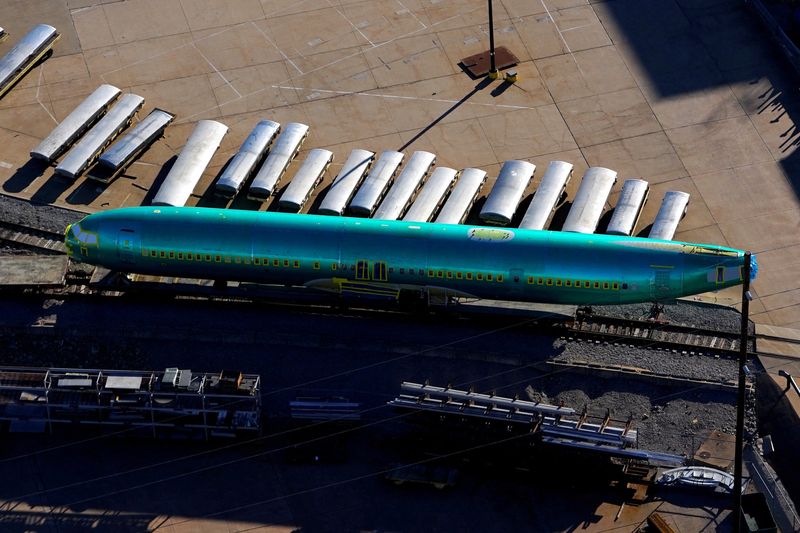Explore our views on recent developments in the world of brands
Inside Boeing’s Struggle to Revive Its Best-Selling 737 MAX
Boeing, one of the world’s leading aerospace manufacturers, is facing a major challenge as it attempts to ramp up production of its best-selling 737 MAX jetliner. After a debilitating strike at many of Boeing’s U.S. factories that ended more than a month ago, the company has been carefully navigating the process of restarting production. While Boeing’s cautious approach is being praised for prioritizing safety and quality, it has also created new obstacles in an already fragile supply chain.

A Slow and Careful Rebuild
The 737 MAX factory near Seattle has been moving at a deliberate pace in recent weeks. Workers inside the factory have been meticulously inspecting half-constructed planes for flaws that could have been missed during the seven-week work stoppage. Many of these employees have had to review manuals to renew their safety certifications, which had expired during the break. At one point in mid-November, the factory appeared so quiet that one employee even left early after realizing that his task of replenishing fastener bins was unnecessary due to the slowdown.
As of late November, no new 737 MAX jets had been completed. Boeing has acknowledged this, confirming that the production restart occurred only in the past week. While the company has moved cautiously, this approach is being viewed as a positive shift from the years of rushing production that had earlier contributed to safety concerns and regulatory scrutiny.
The Push for Safety and Quality
This cautious restart has been commended by regulators and airline CEOs, who have expressed relief that Boeing is taking a more methodical approach to its production process. This change in strategy comes after several years of controversy surrounding the 737 MAX, particularly following the grounding of the jet in 2019 after two fatal crashes involving the model. Boeing CEO Kelly Ortberg has made it clear that the company is committed to ensuring both safety and quality in the production of its most important aircraft.
However, the slow pace of the restart has left smaller suppliers, many of whom had to cut jobs or reduce operating hours during the strike, uncertain about how to proceed. Some suppliers are hesitating to ramp up their operations due to lingering concerns about demand and supply chain reliability. One supplier explained that parts that once took a day to process now take an entire week, further delaying production schedules. This has created additional uncertainty for Boeing and its partners as they work to restore full production.
A Fragile Supply Chain
The issue is not just limited to Boeing’s factory. Both Boeing and its European rival Airbus have struggled with meeting production targets due to persistent supply chain delays. In October, Ortberg acknowledged that the return from the strike would be “bumpy” and that the company would face challenges in regaining full production capacity. Many of Boeing's suppliers, some of whom are still recovering from the effects of the COVID-19 pandemic and the 2019 grounding, have been hit hard by the strike.
Boeing has stressed that it will continue to steadily increase production as part of its safety and quality plan. The company is also focused on ensuring that its entire production system operates smoothly and predictably, which includes working closely with suppliers to resolve any lingering issues and improve collaboration. Jessica Kowal, a spokesperson for Boeing, emphasized that transparency and ongoing dialogue with suppliers are key to ensuring a stable supply chain and meeting customer and regulatory expectations.
Impact on Suppliers
The effects of the strike and the subsequent production slowdown are particularly evident among Boeing’s smaller suppliers. Many of these companies had already faced significant challenges in recent years due to the fluctuating demand for aircraft parts and materials. The COVID-19 pandemic severely impacted production schedules, and the 2019 grounding of the 737 MAX led to further instability. Now, with the factory restart still in its early stages, many suppliers are unsure of how to proceed.
Some suppliers have had to make difficult decisions regarding staffing levels and production capacity. The uncertainty surrounding Boeing’s production timeline, combined with the ongoing supply chain issues, has made it difficult for smaller companies to confidently invest in additional resources. One industry source noted that some suppliers are hesitant to bring back employees or ramp up operations, fearing that they may not be able to meet demand if Boeing's production targets continue to be adjusted.
Regulatory Scrutiny and Boeing’s Commitment to Quality
The grounding of the 737 MAX in 2019 was a significant turning point for Boeing. Following the crashes of Lion Air Flight 610 and Ethiopian Airlines Flight 302, the model was grounded worldwide, leading to intense scrutiny from regulators and the public. Since then, Boeing has been working tirelessly to regain the trust of both regulatory authorities and its customers.
The company has faced intense pressure to ensure that its aircraft meet the highest safety standards. Boeing has committed to taking a more cautious and deliberate approach to production, acknowledging the importance of rebuilding its reputation and ensuring that its planes are as safe as possible. This is particularly important given the heightened regulatory oversight following the 737 MAX crisis.
Boeing’s effort to restart production of the 737 MAX is a delicate balancing act between restoring its supply chain, ensuring the safety and quality of its planes, and managing the expectations of regulators, airlines, and suppliers. While the company’s slow and cautious approach has been welcomed by some, it has also led to challenges, particularly in terms of supply chain delays and uncertainty among smaller suppliers. The coming months will be crucial as Boeing works to navigate these obstacles and regain full production capacity, all while keeping safety at the forefront of its operations. The aerospace giant’s success in these efforts will have significant implications for the future of the 737 MAX and the company’s overall recovery.
